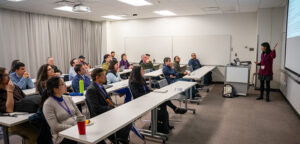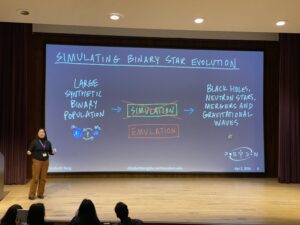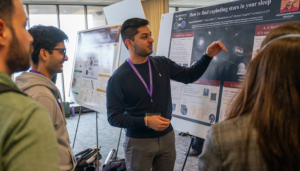On April 2, 2024, Northwestern Information Technology (NUIT) held their annual CoDEx symposium, an all-day campus-wide showcase of computational and data-enabled research at Northwestern. Open to faculty, postdocs, students, researchers, and staff, the symposium is designed to foster connections and research collaborations. As in previous years, many CIERA members attended, gave talks, and excelled in data science challenges. 
During morning parallel sessions, CIERA Professor Wen-fai Fong presented her talk “Following Data from Telescopes to Publication: Observing our Colorful and Transient Universe“. In it she outlined the ways in which the discoveries of cosmic transients are enabled by advances in detector technology and data processing techniques and the statistical challenges posed by expanding to all wavelengths on the electromagnetic spectrum. Prof Fong placed this challenge within the context of her research group’s work, outlining ways in which Northwestern’s computing resources have been particularly beneficial and areas where interdisciplinary collaboration would be an asset.

In a lightning talk CIERA graduate student Elizabeth Teng presented “Emulating Stellar Evolution with Deep Learning: I Can’t Believe It’s Not Hydrostatic Equilibrium!” A member of CIERA Director Vicky Kalogera‘s research group, Teng focused on her research into the evolution of binary star systems, the “laboratories for testing theoretical models”. In particular, she spoke about the novel binary population synthesis code POSYDON and its ability to bypass the computational bottleneck to deliver detailed information about the diversity of binary stars.
Another component of CoDEx is the visualization challenge, which celebrate effective data science communication.  This year, two CIERA graduate students won first and second place in the “Animation” category. Nabeel Rehemtulla, a member of CIERA Professor Adam Miller‘s group, took home first place for his visualization “Automated Surveying of Supernovae with the Zwicky Transient Facility“, which details his work with the Bright Transient Survey (BTS), a team seeking to discover and classify as many supernovae as possible.
This year, two CIERA graduate students won first and second place in the “Animation” category. Nabeel Rehemtulla, a member of CIERA Professor Adam Miller‘s group, took home first place for his visualization “Automated Surveying of Supernovae with the Zwicky Transient Facility“, which details his work with the Bright Transient Survey (BTS), a team seeking to discover and classify as many supernovae as possible.
Fulya Kiroglu, a member of CIERA Professor Fred Rasio‘s group, won second place for her visualization “Hydrodynamical Simulations of Black Hole Star Collisions“, which conveys the findings that close encounters between stars and black holes occur frequently in dense star clusters.
Visualizations were evaluated by 5 judges, impartially including CIERA Professor Aaron Geller, based on presentation clarity and aesthetics, visualization method used, and accessibility.
Congratulations Nabeel, Fulya, Elizabeth, Wen-fai, and Aaron!
Elizabeth Teng photo by Michael Stroh, all others by Rob Hart

